”As a former language major, I know the importance of speaking daily in the target language to your kids. However, that’s easier said in a language lab than done with the daily grunt of motherhood. . . .None of us have to teach the next generation alone.
Mariam Tocco, linguist, home-schooling parent of two, blogger
As soon as I began homeschooling my toddler, I knew that I needed to supplement for Arabic. Arabic has always been of big importance to me as I raise my two kids. And when we made the decision to homeschool, I really wanted to include Arabic in that. However, I knew, whichever curriculum we picked, I was on my own with Arabic.
Now, don’t get me wrong. I have been intentional with including Arabic as a part of our everyday exploring ever since my first was born, but I knew that once we hit the preschool age, I was going to need something more organized and stable. As a former language major, I know the importance of speaking daily in the target language to your kids. However, that’s easier said in a language lab than done with the daily grunt of motherhood.
There have been many days where I beat myself up for not speaking in Arabic all day, for code switching throughout the day. If I said something like “Yalla, come here” instead of “Yalla Ta3ali” I would lament over the fact that they’re never going to learn because I can’t stick to one language. Well, friends, that’s just NOT true. Yes, speaking is so important but they also learn when they’re engaged. Throughout the past few years of trial and error, I’ve collected some very simple resources to supplement our Arabic learning throughout our days.
1. “Oh, the things you can read!”- Books! Books! Books!
I know that this goes without saying but kids love books. I’m extremely picky with the books I buy because I want my kids to use these books for a long time.
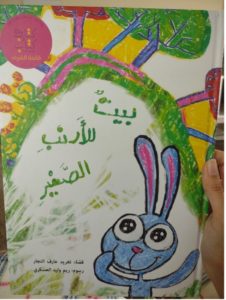
Bet Al-arnab Al Sagheer (بيت الارنب الصغير)
This story book is definitely for a 2+ age but it’s so precious and all of the songs are really fun. I usually read them with different voices and my toddler loves it! The illustrations are also very engaging, and it activates kids’ imagination about how different animals interact with each other. Find it here on Amazon.
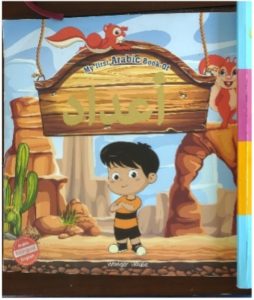
A3dad (اعداد)
This one is actually NOT one of my favorite counting books but…my toddler loves it! The pictures are so fun for kids. The counting is great too but my only issue is that it has the numeral in Arabic but the adjective in English. I would prefer both be in Arabic. The pictures are great though and because the actual numerals are in Arabic it’s a great way to get your kids visually exposed to what the numbers look like. You can find it here on Amazon.
This book is incredibly catchy. Your kids will catch the letters so quick because it rolls with the tongue. So for example: Alif Ananas, Baa Bateekh, etc. Point being is that if kids find it catchy, they will remember it because it sticks in their minds. In language studies we call that “making something sticky”. I highly recommend getting this book when beginning the alphabet. You can find it here on Amazon
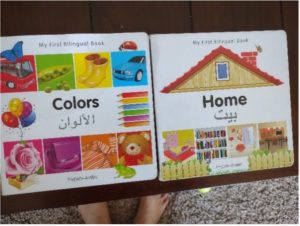
Both of these sets of books (from Milet Publishing and Oxford University Press) are short and sweet!
“Colors” & “Home” are board books so they’re perfect for infants. In fact my 7 month old loves grabbing and chewing on them when I take them out to read.
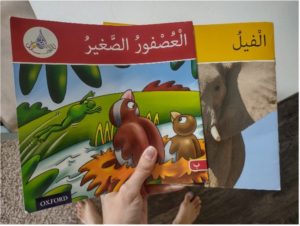
The two animal books on the right have been really helpful for learning about zoo animals. The bird book is a narrative style and those are not easy to find. They’re not board books so I don’t let my infant chew on them but they’re perfect for a quick story for my toddler. These are also a favorite of ArabishWay. Read more about the Arabic Reader Series and where to find them here.
2. Audio Books/Podcast Stories
When my toddler started swimming lessons in April. I was driving every day for 40 minutes with her and my crying 3 month old. So, I needed something to occupy us in the car. We discovered the beauty of Audiobooks.

It took a while, but I discovered a really awesome story program in Arabic called “Story Time With Teta” on Spotify. The stories are just precious and about 15 mins each. Perfect for car rides.

The other Audiobook we’ve recently discovered is called “بوتكاست قبل النوم”
I absolutely love the beginning of the podcast…it makes you feel like you’re in a 1750’s opera but like…Arab! This podcast has fun kid stories about many different topics.
Each story is about 10-15 mins long. You can find them on Spotify too.
3. Music + Dancing
Arabic Podcasts are also great for the adults too, it helps keep your Arabic sharp!
I dedicate a good chunk of each day to music. Music is great in helping our kids memorize alphabets, numbers, seasons, etc. But what I love most about it is that by it’s very nature music will teach our kids about culture. The types of instruments being used and the way songs are sung says a lot about the time and the heritage they were written in. I have a couple of awesome Spotify playlists that we religiously follow! Here are some of them.
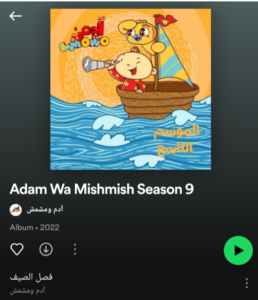
Adam Wa Mishmish: We have been listening to Adam wa Mishmish for years now, they have songs about the Arabic alphabet called “Alif, Baa, Taa”, songs about seasons or موسم, songs about family or اسرة, animals at the zoo, etc. The songs are perfect for many different ages and they are incredibly catchy.
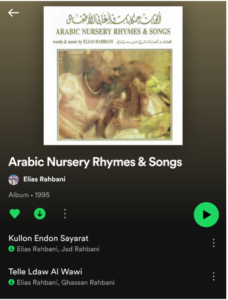
Arabic Nursery Rhymes & Songs by Elias Rahbani: This playlist has all the old fashioned songs we grew up with as young Arabs like Kullon Endon Sayarat (which Laila Taji made into a book – you can find it on Amazon). The playlist itself has a total of 20-30 nursery rhymes and they will not only bring memories, but I think they’re sung in the original voice. When I heard Chitti Chitti on the playlist, I imagined Fairuz going on stage with her long robes and singing her songs about winter. It might bring you tears of joy and it might get your kids to start dancing.
I want to conclude by saying that none of us have to teach the next generation alone. I think as Arab Americans, we feel like we have the pressure of bringing our language and heritage to the next generation and that’s a big burden. Albeit a good one but it’s still a burden. But the beauty of the internet is that there are lots of resources out there! We don’t have to do any of it alone. I hope you find this list, helpful, doable and encouraging.

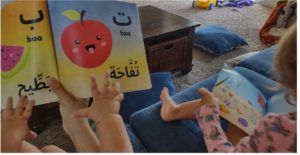

I love the way you incorporate culture through music and dance. Children learn so much more than the language they learn to broaden their experience through exposure. Thanks for sharing your story!
Cheers awesome mom!
Marianne